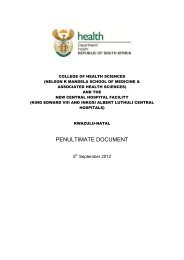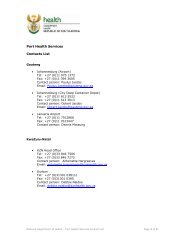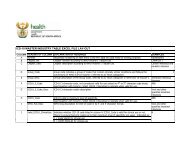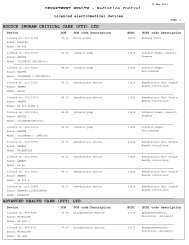National Norms and Standards relating to Environmental Health
National Norms and Standards relating to Environmental Health
National Norms and Standards relating to Environmental Health
Create successful ePaper yourself
Turn your PDF publications into a flip-book with our unique Google optimized e-Paper software.
a) All food onboard must be s<strong>to</strong>red <strong>and</strong> maintained at the correct temperatures;b) Onboard s<strong>to</strong>rage compartments must be cleaned <strong>and</strong> disinfected regularly;c) Onboard s<strong>to</strong>rage compartments must be made of material that is easily cleanable;d) All equipment must be maintained in a serviceable condition <strong>and</strong> must be kept clean at all times;e) Containers used for serving of food must only be used for the intended purpose;f) Walls, ceilings, floor <strong>and</strong> door of vehicles transporting food on<strong>to</strong> aircraft must be lined with smooth,impervious material for easy cleaning;g) Vehicles transporting food on<strong>to</strong> aircraft must be in a serviceable condition <strong>and</strong> kept in clean condition;h) All equipment used for the preparation <strong>and</strong> serving of food must be kept in clean condition;i) Food waste must be removed from the aircraft as soon as possible after arrival; <strong>and</strong> disposed offthrough in an approved manner.5. Vec<strong>to</strong>r Controla) Aircrafts must be kept free of any vec<strong>to</strong>rs <strong>and</strong> flies;b) Aircrafts from Yellow Fever <strong>and</strong> Malaria affected areas must be disinfected according <strong>to</strong> theInternational <strong>Health</strong> Regulations (2005).6. Cargo Holds <strong>and</strong> Containersa) Aircraft cargo holds must be kept in clean condition;b) They must be kept free of infectious materials, vec<strong>to</strong>rs <strong>and</strong> rodents;c) They must be constructed of a material that facilitates easy cleaning.SECTION 3:MONITORING OF WATER QUALITY ON BOARD AIRCRAFT/ IN AVIATIONTravel can facilitate the transfer of communicable diseases <strong>and</strong> one of the risks that are associated withair travel is posed by the potential for microbial contamination of aircraft water by animal or humanexcreta. This contamination may originate from source waters or may occur during transfer operations orwhile water is s<strong>to</strong>red on board the aircraft. If proper procedures <strong>and</strong> safer sanitation practices are notcontinuously followed <strong>to</strong> ensure the safety of water for human consumption, the risk of water <strong>and</strong> foodbornediseases in aviation increases. The provision of a potable water source at the airport might notnecessarily be an indication that the water on board the aircraft is safe as it may have been contaminatedduring transfer <strong>and</strong> s<strong>to</strong>rage or distribution in the aircraft. Generally, the aircraft drinking-water supply <strong>and</strong>transfer chain consists of four major components: the source of water coming in<strong>to</strong> the airport; the airportwater system, which includes the on-site distribution system <strong>and</strong> may also include treatment facilities ifthe airport produces its own potable water; the transfer point sometimes referred <strong>to</strong> as the wateringpoint; <strong>and</strong> the aircraft water system, which includes the water service panel, the filler neck of the aircraftfinished water s<strong>to</strong>rage tank <strong>and</strong> all finished water s<strong>to</strong>rage tanks, including refillable containers/urns,piping, treatment equipment <strong>and</strong> plumbing fixtures within the aircraft that supply water <strong>to</strong> passengers orcrew.1. Water supplied in aircrafts must be obtained from a source that has well operated <strong>and</strong> maintainedsystems <strong>and</strong> that conforms <strong>to</strong> SANS 241 <strong>and</strong> the WHO. Guideline for sanitation <strong>and</strong> hygiene inaviation.2. Potable water at airports must comply <strong>to</strong> the SANS: 241 with regards <strong>to</strong> its bacteriological, chemical<strong>and</strong> aesthetic quality.3. A Water Safety Plan covering water management within airports from receipt of the water through <strong>to</strong>its transfer <strong>to</strong> the aircraft should be in place for airports <strong>to</strong> ensure water safety in aviation.4. The quantity of potable water on board must be sufficient <strong>to</strong> meet the needs of all people on boardthe aircraft, for drinking, food preparation, personal hygiene <strong>and</strong> other uses/purposes.5. Potable water provided <strong>to</strong> airports <strong>and</strong> aircrafts must be from an uncontaminated source that isapproved by the approved by the competent authority (DWA).6. PHO must test drinking water supply <strong>to</strong> the ships <strong>and</strong> the ports regularly for fitness of humanconsumption both on an operational level <strong>and</strong> on compliance level.DOH. <strong>Norms</strong> <strong>and</strong> st<strong>and</strong>ards for environmental health in South Africa Feb 2013 83


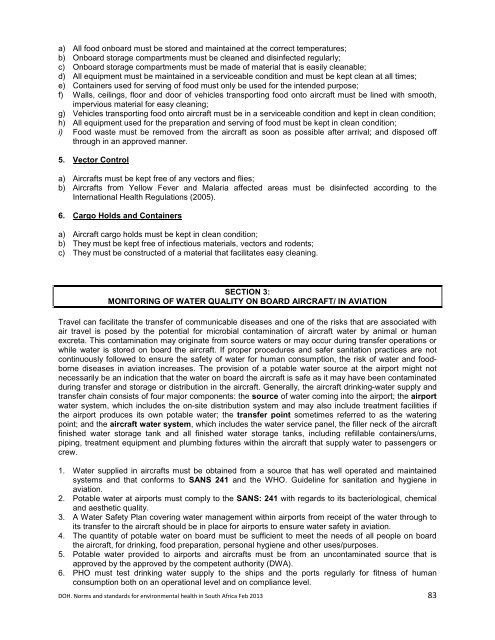
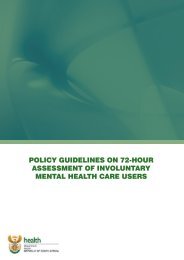
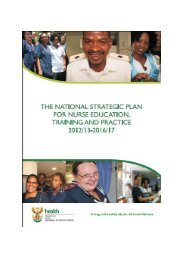
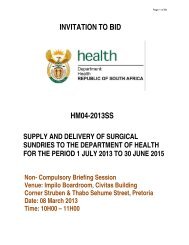
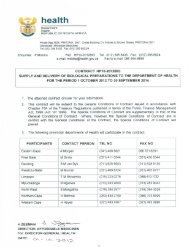
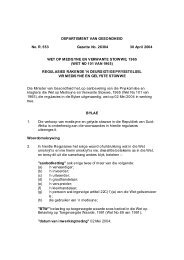
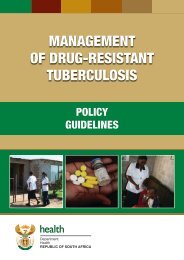
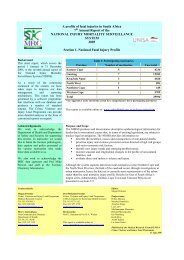
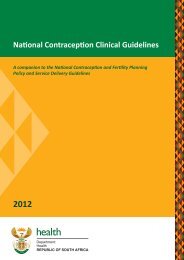
![A monograph of the management of postpartum haemorrhage [2011]](https://img.yumpu.com/15578784/1/184x260/a-monograph-of-the-management-of-postpartum-haemorrhage-2011.jpg?quality=85)
